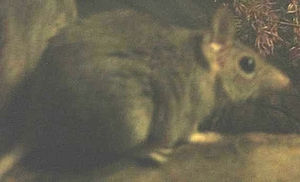Eyepot broad-footed pouch mouse
| Eyepot broad-footed pouch mouse | ||||||||||||
|---|---|---|---|---|---|---|---|---|---|---|---|---|

Eyepot broad-footed pouch mouse ( Antechinus bellus ) |
||||||||||||
| Systematics | ||||||||||||
|
||||||||||||
| Scientific name | ||||||||||||
| Antechinus bellus | ||||||||||||
| ( Thomas , 1904) |
The eye-spot broad-footed pouch mouse ( Antechinus bellus ) is a member of the predator family (Dasyuridae) living in the tropical north of Australia . This locally common species is very close to the yellow-footed pouch mouse and was originally described as Phascogale bella .
Appearance
The broad-footed eye-spot mouse is one of the largest representatives of this genus . Adult animals can reach 112 to 145 millimeters head-trunk length and 90 to 125 millimeters tail length, with a weight of 25 to 60 grams. With its coloring - predominantly pale to gray, with a white chin and white paws - it is also the lightest broad-footed pouch mouse .
distribution
The broad-footed eye-spot mouse occurs only in the tropical northern territory ( Australia ), whereby the southern limit of the distribution area can be drawn at approximately 14 ° south latitude.
Habitat
Forests influenced by the monsoon are populated, which are usually dominated by eucalyptus . These trees have often been hollowed out by termites and can therefore offer shelter and protection; there is also a pronounced layer of grass or shrubbery in the forests. The forests are often on fire during the dry season. It is the only broad-footed pouch mouse found in this area and habitat.
The broad-footed eye-spot mouse seeks protection in hollow tree trunks or lying on the ground. Animals have also been observed which, when threatened, fled into tree hollows at a height of 10 meters. Otherwise, nocturnal activity and foraging is limited to the ground.
food
In the few studies carried out on food of this type, only remains of insects were found in the stomachs of the animals .
Reproduction
The mating season of this species, which occurs in the tropics, seems to be in August, but sperm production can take place in males as early as June. The peculiarities of the mating correspond to the general pattern in broad-footed pouch mice , so all males die shortly after mating. From late September to early October, births of 10 young animals were observed, but pregnant animals with 16 embryos were also examined. Since these animals only have 10 teats, some young animals are lost in such a case. However, exact data are not available because it has not yet been possible to breed this species in captivity.
Danger
The IUCN lists the eyespot broad-footed pouch mouse as Least Concern (not endangered).
literature
- JH Calaby in: Ronald Strahan (Ed.): Complete book of Australian mammals. The national photographic index of Australian wildlife. Angus & Robertson, London 1991, ISBN 0-207-14454-0 , p. 38.
Web links
- Antechinus bellus in the endangered Red List species the IUCN 2016 Posted by: J. Woinarski & AA Burbidge, 2014. Accessed July 21, 2020th
Individual evidence
- ↑ MSW Scientific Names ( page no longer available , search in web archives )
